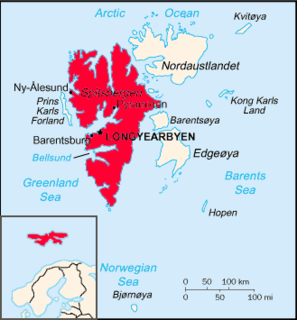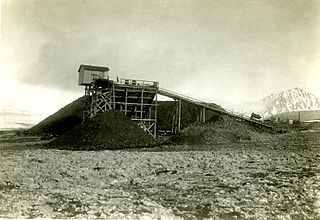Related Research Articles

Svalbard, previously known as Spitsbergen, or Spitzbergen, is a Norwegian archipelago in the Arctic Ocean. Situated north of mainland Europe, it is about midway between the northern coast of Norway and the North Pole. The islands of the group range from 74° to 81° north latitude, and from 10° to 35° east longitude. The largest island is Spitsbergen, followed by Nordaustlandet and Edgeøya, and the largest settlement is Longyearbyen.

Spitsbergen is the largest and only permanently populated island of the Svalbard archipelago in northern Norway.

Longyearbyen is the largest settlement and the administrative centre of Svalbard, Norway. It stretches along the foot of the left bank of the Longyear Valley and on the shore of Adventfjorden, the short estuary leading into Isfjorden on the west coast of Spitsbergen, the island's broadest inlet. Since 2002 Longyearbyen Community Council has had many of the same responsibilities as a Norwegian municipality, including utilities, education, cultural facilities, fire brigade, roads and ports. The town is the seat of the Governor of Svalbard. It is the world's northernmost settlement of any kind with more than 1,000 permanent residents. Since 2015 Arild Olsen has served as Mayor.

Ny-Ålesund is a small town in Oscar II Land on the island of Spitsbergen in Svalbard, Norway. It is situated on the Brøgger peninsula (Brøggerhalvøya) and on the shore of the bay of Kongsfjorden. The company town is owned and operated by Kings Bay, which provides facilities for permanent research institutes from ten countries. The town is ultimately owned by the Ministry of Climate and Environment and is not incorporated. Ny-Ålesund has an all-year permanent population of 30 to 35, with the summer population reaching 120. Its facilities include Ny-Ålesund Airport, Hamnerabben, Svalbard Rocket Range, a port and Ny-Ålesund Town and Mine Museum, as well as fifteen permanent research stations. It is the northernmost functional civilian settlement in the world.

Barentsburg is the second-largest settlement on Svalbard, with about 455 inhabitants (2020), almost entirely made up of ethnic Russians and Ukrainians.
The polar archipelago of Svalbard was first discovered by Willem Barentsz in 1596, although there is disputed evidence of use by Pomors or Norsemen. Whaling for bowhead whales started in 1611, dominated by English and Dutch companies, though other countries participated. At that time there was no agreement about sovereignty. Whaling stations, the largest being Smeerenburg, were built during the 17th century, but gradually whaling decreased. Hunting was carried out from the 17th century by Pomors, but from the 19th century it became more dominated by Norwegians.

Svalbard lies under the sovereignty of Norway, but the Svalbard Treaty places several restrictions. Norway cannot use the archipelago for warlike purposes, cannot discriminate economic activity based on nationality and is required to conserve the natural environment. Uniquely, Svalbard is an entirely visa-free zone. Everybody may live and work in Svalbard indefinitely regardless of country of citizenship. Svalbard Treaty grants treaty nationals equal right of abode as Norwegian nationals. Non-treaty nationals may live and work indefinitely visa-free as well. "Regulations concerning rejection and expulsion from Svalbard" is in force on non-discriminatory basis.

Ny-Ålesund Airport, Hamnerabben is an airport serving the research community of Ny-Ålesund in Svalbard, Norway. The airport is owned by Kings Bay, who also owns the company town. The only flights available are to Svalbard Airport, Longyear, operated two to four times a week by Lufttransport using Dornier 228 aircraft. The services are organized as corporate charters and tickets are only available after permission from Kings Bay.

Svea Airport is a private airport located in and serving the Sveagruva in Svalbard, Norway. The airport is owned and operated by Store Norske Spitsbergen Kulkompani, who use the airport to transport their coal mining workers from the company town to Longyearbyen and Svalbard Airport, Longyear. The airport features a gravel runway measuring 800 by 30 meters. Flights are operated about thirty times per week by Lufttransport using their two Dornier 228s.

Store Norske Spitsbergen Kulkompani (SNSK), or simply Store Norske, is a Norwegian coal mining company based on the Svalbard archipelago. It was formed in 1916, after a Norwegian purchase of the American Arctic Coal Company (ACC).

Arktikugol is a Russian coal mining unitary enterprise which operates on the islands of Spitsbergen in Svalbard, Norway. Owned by the Government of Russia, Arktikugol currently has limited mining in Barentsburg. It has carried out mining operations and still owns the towns of Pyramiden and Grumant, with its port at Colesbukta. The company is headquartered in Moscow and is the official agency through which Russia, and previously the Soviet Union, exercised its Svalbard policy.

John Munro Longyear, Sr. was an American businessman and noted developer of timber and mineral lands in the Upper Peninsula of Michigan who became the central figure behind the Arctic Coal Company, which surveyed and mined coalfields on Spitsbergen, now Svalbard, from 1905 to 1916. This company developed a settlement on Spitsbergen able to accommodate up to around 500 people which became known as Longyear City, now Longyearbyen, adjacent Advent Bay.

The economy of Svalbard is dominated by coal mining, tourism and research. In 2007, there were 484 people working in the mining sector, 211 people working in the tourism sector and 111 people working in the education sector. The same year, mining gave a revenue of 2.008 billion kr, tourism NOK 317 million and research 142 million. In 2006, the average income for economically active people was NOK 494,700, or 23% higher than on the mainland. Almost all housing is owned by the various employers and institutions and rented to their employees; there are only a few privately owned houses, most of which are recreational cabins. Because of this, it is nearly impossible to live on Svalbard without working for an established institution. The Spitsbergen Treaty and Svalbard Act established Svalbard as an economic free zone and demilitarized zone in 1925.
Camp Morton was a coal mining encampment on Spitsbergen island in the Svalbard archipelago, Norway. It was located on the northern shores of Van Mijenfjorden, near the sea entrance. It was part of an effort by British investors and entrepreneurs to extract resources from Spitsbergen, at that time open to various nations' claims for development.

Nybyen is a small settlement located on the southern outskirts of Longyearbyen, on the island of Spitsbergen, in the Svalbard archipelago of Norway. The name is Norwegian and translates as The New Town.

The Longyear Valley is a valley and ravine in Svalbard. It slightly winds 40 kilometres (25 mi) WNW ending in Adventfjorden, facing west, the broadest inlet of Spitsbergen, the main landmass. It has a few wind gaps to the south and north-east over small glaciers, under which small streams form. It is between mountains Platåberget and Gruvefjellet. The town of Longyearbyen is at its foot, which is named for the American industrialist John Munroe Longyear. The Longyear River is, like all the island's rivers, silted from surrounding glaciers.

Adventtoppen is a mountain on the east side of Adventfjorden in the northern part of Nordenskiöld Land on the island of Spitsbergen in Svalbard, Norway. It is 786 metres (2,579 ft) tall. In 1901, Bergen-Spitsbergen Kullgrube-kompani started mining coal in Adventtoppen. During their first summer season, they mined 5 tonnes. They lived on board their ship and freighted the coal with a row-boat. In 1903, they produced 40 tonnes. The mountain was first ascended by A. Hoel in 1916. It was ascended again by W. Solheim and M. Abrahamsen on 23 July 1922 for triangulation and photgrammetric work.

The history of Ny-Ålesund began in 1610, when coal deposits were discovered around Kongsfjorden. Not until the 1860s were they investigated more carefully. Ålesund-based Peter Brandal bought the claims in 1916 and established the company Kings Bay. The town, originally known as Brandal City and Kings Bay, was founded that summer when coal mining commenced. The first research installation, a geophysical station at Kvadehuken, was established in 1920. The mining was soon unprofitable and was kept running through state subsidies. In the mid-1920s the town was used for a series of airship expeditions towards the North Pole.

Barentsburg Heliport, Heerodden is a private heliport located at Heerodden, serving the mining town of Barentsburg in Svalbard, Norway. The airport is owned and operated by Arktikugol, which also owns the company town. The airport features a 91-by-21-meter runway, two hangars and an administration building with a control tower. There are two Mil Mi-8 helicopters based at Heerodden, which are operated by Spark+. Flights are provided to Svalbard Airport, Longyear and Pyramiden Heliport.

Agriculture in Svalbard – the archipelago containing the world's northernmost permanently inhabited settlements – has a short history, and remains a minor economic factor, but has nonetheless had a culturally and socially significant role, as well as an ecologic impact. Svalbard is home to the Global Seed Vault, which serves to protect the world's biological and agricultural diversity. Polar Permaculture Solutions, AS was formed in January 2015. Polar Permaculture has been focused on producing locally grown food in town, and also with composting food waste.
References
- Bibliography
- Holm, Kari (1999). Longyearbyen – Svalbard: historisk veiviser (in Norwegian). ISBN 82-992142-4-6.
- Hartnell, Cameron C. "Arctic Network Builders : the Arctic Coal Company's Operations on Spitsbergen and Its Relationship with the Environment." Dissertation, Michigan Technological University, 2009.
- Notes
- ↑ "Longyearbyen". Norwegian Polar Institute. Archived from the original on 20 January 2012. Retrieved 15 March 2012.
- 1 2 Holm (1999): 46
- ↑ Holm (1999): 148
- ↑ Holm (1999): 47
- ↑ Holm (1999): 119